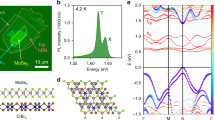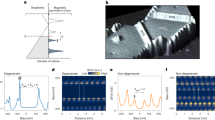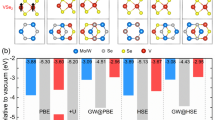Abstract
Magnetic proximity interactions between atomically thin semiconductors and two-dimensional magnets provide a means to manipulate spin and valley degrees of freedom in non-magnetic monolayers, without using applied magnetic fields1,2,3. In such van der Waals heterostructures, magnetic proximity interactions originate in the nanometre-scale coupling between spin-dependent electronic wavefunctions in the two materials, and typically their overall effect is regarded as an effective magnetic field acting on the semiconductor monolayer4,5,6,7,8. Here we demonstrate that magnetic proximity interactions in van der Waals heterostructures can in fact be markedly asymmetric. Valley-resolved reflection spectroscopy of MoSe2/CrBr3 van der Waals structures reveals strikingly different energy shifts in the K and K′ valleys of the MoSe2 due to ferromagnetism in the CrBr3 layer. Density functional calculations indicate that valley-asymmetric magnetic proximity interactions depend sensitively on the spin-dependent hybridization of overlapping bands and as such are likely a general feature of hybrid van der Waals structures. These studies suggest routes to control specific spin and valley states in monolayer semiconductors9,10.
This is a preview of subscription content, access via your institution
Access options
Access Nature and 54 other Nature Portfolio journals
Get Nature+, our best-value online-access subscription
$29.99 / 30 days
cancel any time
Subscribe to this journal
Receive 12 print issues and online access
$259.00 per year
only $21.58 per issue
Buy this article
- Purchase on Springer Link
- Instant access to full article PDF
Prices may be subject to local taxes which are calculated during checkout




Similar content being viewed by others
Data availability
All data are available from the corresponding author upon reasonable request.
Change history
14 March 2023
A Correction to this paper has been published: https://doi.org/10.1038/s41563-023-01526-z
25 January 2023
A Correction to this paper has been published: https://doi.org/10.1038/s41563-023-01482-8
References
Žutić, I., Matos-Abiague, A., Scharf, B., Dery, H. & Belashchenko, K. Proximitized materials. Mater. Today 22, 85–107 (2019).
Gibertini, M., Koperski, M., Morpurgo, A. F. & Novoselov, K. S. Magnetic 2D materials and heterostructures. Nat. Nanotechnol. 14, 408–419 (2019).
Mak, K. F., Shan, J. & Ralph, D. Probing and controlling magnetic states in 2D layered magnetic materials. Nat. Rev. Phys. 1, 646–661 (2019).
Zhao, C. et al. Enhanced valley splitting in monolayer WSe2 due to magnetic exchange field. Nat. Nanotechnol. 12, 757–762 (2017).
Zhong, D. et al. Van der Waals engineering of ferromagnetic semiconductor heterostructures for spin and valleytronics. Sci. Adv. 3, e1603113 (2017).
Norden, T. et al. Giant valley splitting in monolayer WS2 by magnetic proximity effect. Nat. Commun. 10, 4163 (2019).
Ciorciaro, L., Kroner, M., Watanabe, K., Taniguchi, T. & Imamoglu, A. Observation of magnetic proximity effect using resonant optical spectroscopy of an electrically tunable MoSe2/CrBr3 heterostructure. Phys. Rev. Lett. 124, 197401 (2020).
Zhong, D. et al. Layer-resolved magnetic proximity effect in van der Waals heterostructures. Nat. Nanotechnol. 15, 187–191 (2020).
Xiao, D., Liu, G.-B., Feng, W., Xu, X. & Yao, W. Coupled spin and valley physics in monolayers of MoS2 and other group-VI dichalcogenides. Phys. Rev. Lett. 108, 196802 (2012).
Xu, X., Yao, W., Xiao, D. & Heinz, T. F. Spin and pseudospins in layered transition metal dichalcogenides. Nat. Phys. 10, 343–350 (2014).
Lazić, P., Belashchenko, K. D. & Žutić, I. Effective gating and tunable magnetic proximity effects in two-dimensional heterostructures. Phys. Rev. B 93, 241401(R) (2016).
Xu, J. et al. Spin inversion in graphene spin valves by gate-tunable magnetic proximity effect at one-dimensional contacts. Nat. Commun. 9, 2869 (2018).
Mak, K. F. & Shan, J. Photonics and optoelectronics of 2D semiconductor transition metal dichalcogenides. Nat. Photon. 10, 216–226 (2016).
Wang, G. et al. Excitons in atomically thin transition metal dichalcogenides. Rev. Mod. Phys. 90, 021001 (2018).
Wang, Q. H., Kalantar-Zadeh, K., Kis, A., Coleman, J. N. & Strano, M. S. Electronics and optoelectronics of two-dimensional transition metal dichalcogenides. Nat. Nanotechnol. 7, 699–712 (2012).
Schaibley, J. R. et al. Valleytronics in 2D materials. Nat. Rev. Mater. 1, 16055 (2016).
Qi, J., Li, X., Niu, Q. & Feng, J. Giant and tunable valley degeneracy splitting in MoTe2. Phys. Rev. B 92, 121403(R) (2015).
Zhang, Q., Yang, S. A., Mi, W., Cheng, Y. & Schwingenschlögl, U. Large spin-valley polarization in monolayer MoTe2 on top of EuO(111). Adv. Mater. 28, 959–966 (2016).
Scharf, B., Xu, G., Matos-Abiague, A. & Žutić, I. Magnetic proximity effects in transition-metal dichalcogenides: converting excitons. Phys. Rev. Lett. 119, 127403 (2017).
Zollner, K., Faria, P. E.Jr & Fabian, J. Proximity effects in MoSe2 and WSe2 heterostructures with CrI3: twist angle, layer, and gate dependence. Phys. Rev. B 100, 085128 (2019).
Zhang, Z., Ni, X., Huang, H., Hu, L. & Liu, F. Valley splitting in the van der Waals heterostructure WSe2/CrI3: the role of atom superposition. Phys. Rev. B 99, 115441 (2019).
Xie, J., Jia, L., Shi, H., Yang, D. & Si, M. Electric field mediated large valley splitting in the van der Waals heterostructure WSe2/CrI3. Jpn. J. Appl. Phys. 58, 010906 (2019).
Lyons, T. P. et al. Interplay between spin proximity effect and charge-dependent exciton dynamics in MoSe2/CrBr3 van der Waals heterostructures. Nat. Commun. 11, 6021 (2020).
Chen, W. et al. Direct observation of van der Waals stacking-dependent interlayer magnetism. Science 366, 983–987 (2019).
Kim, H. H. et al. Evolution of interlayer and intralayer magnetism in three atomically thin chromium trihalides. Proc. Natl Acad. Sci. USA 116, 11131–11136 (2019).
Soriano, D., Katsnelson, M. I. & Fernandez-Rossier, J. Magnetic two-dimensional chromium trihalides: a theoretical perspective. Nano Lett. 20, 6225–6234 (2020).
Fisher, M. E. The renormalization group in the theory of critical behavior. Rev. Mod. Phys. 46, 597–616 (1974).
Stier, A. V., McCreary, K. M., Jonker, B. T., Kono, J. & Crooker, S. A. Exciton diamagnetic shifts and valley Zeeman effects in monolayer WS2 and MoS2 to 65 Tesla. Nat. Commun. 7, 10643 (2016).
Xu, G., Zhou, T., Scharf, B. & Žutić, I. Optically probing tunable band topology in atomic monolayers. Phys. Rev. Lett. 125, 157402 (2020).
Kim, K. et al. Van der Waals heterostructures with high accuracy rotational alignment. Nano Lett. 16, 1989–1995 (2016).
Robert, C. et al. Optical spectroscopy of excited exciton states in MoS2 monolayers in van der Waals heterostructures. Phys. Rev. Mater. 2, 011001(R) (2018).
Kresse, G. & Joubert, D. From ultrasoft pseudopotentials to the projector augmented-wave method. Phys. Rev. B 59, 1758–1775 (1999).
Kresse, G. & Furthmüller, J. Efficient iterative schemes for ab initio total-energy calculations using a plane-wave basis set. Phys. Rev. B 54, 11169–11186 (1996).
Kresse, G. & Hafner, J. J. Ab initio molecular dynamics for open-shell transition metals. Phys. Rev. B 48, 13115–13118 (1993).
Perdew, J. P., Burke, K. & Ernzerhof, M. Generalized gradient approximation made simple. Phys. Rev. Lett. 77, 3865–3868 (1996).
Grimme, S. Semiempirical GGA-type density functional constructed with a long-range dispersion correction. J. Comput. Chem. 27, 1787–1799 (2006).
Dion, M., Rydberg, H., Schröder, E., Langreth, D. C. & Lundqvist, B. I. Van der Waals density functional for general geometries. Phys. Rev. Lett. 92, 246401 (2004).
Dudarev, S. L., Botton, G. A., Savrasov, S. Y., Humphreys, C. J. & Sutton, A. P. Electron-energy-loss spectra and the structural stability of nickel oxide: an LSDA + U study. Phys. Rev. B 57, 1505–1509 (1998).
Quang, T. L. et al. Scanning tunneling spectroscopy of van der Waals graphene/semiconductor interfaces: absence of Fermi level pinning. 2D Mater. 4, 035019 (2017).
Gusakova, J. et al. Electronic properties of bulk and monolayer TMDs: theoretical study within DFT framework (GVJ-2e method). Phys. Status Solidi A 214, 1700218 (2017).
Zhang, W.-B., Qu, Q., Zhu, P. & Lam, C.-H. Robust intrinsic ferromagnetism and half semiconductivity in stable two-dimensional single-layer chromium trihalides. J. Mater. Chem. C 3, 12457–12468 (2015).
Kormányos, A. et al. k⋅p theory for two-dimensional transition metal dichalcogenide semiconductors. 2D Mater. 2, 022001 (2015).
Herath, U. et al. PyProcar: a Python library for electronic structure pre/post-processing. Comput. Phys. Commun. 251, 107080 (2020).
Kuhlow, B. & Lambeck, M. Magnetic domain structures in CrBr3. Physica B+C 80, 365–373 (1975).
Sun, Q.-C. et al. Magnetic domains and domain wall pinning in atomically thin CrBr3 revealed by nanoscale imaging. Nat. Commun. 12, 1984 (2021).
Acknowledgements
We gratefully acknowledge I. Žutić and B. Urbaszek for helpful discussions. Experimental studies at the National High Magnetic Field Laboratory were supported by the Los Alamos Laboratory Directed Research and Development programme (J.C. and S.A.C.). The National High Magnetic Field Laboratory is supported by National Science Foundation DMR-1644779, the State of Florida and the US Department of Energy. Computational studies were supported in part by the Center for Integrated Nanotechnologies, a US Department of Energy Basic Energy Sciences user facility, in partnership with the Los Alamos National Laboratory Institutional Computing Program for computational resources (C.L. and J.-X.Z). Additional computations were performed at the National Energy Research Scientific Computing Center, a US Department of Energy Office of Science user facility located at Lawrence Berkeley National Laboratory, operated under contract no. DE-AC02-05CH11231 using National Energy Research Scientific Computing Center award ERCAP0020494.
Author information
Authors and Affiliations
Contributions
J.C. and S.A.C. conceived the project. J.C. prepared the samples and performed the optical experiments. C.L. and J.-X.Z. performed the DFT calculations. All authors contributed to writing the manuscript.
Corresponding author
Ethics declarations
Competing interests
The authors declare no competing interests.
Peer review
Peer review information
Nature Materials thanks the anonymous reviewers for their contribution to the peer review of this work.
Additional information
Publisher’s note Springer Nature remains neutral with regard to jurisdictional claims in published maps and institutional affiliations.
Extended data
Extended Data Fig. 1 Additional MCD data and MCD spectra.
a, Hysteresis loops of the MCD signal from the MoSe2/CrBr3 heterostructure, acquired at the B-exciton transition of the MoSe2 monolayer (photon energy = 1.83 eV; cf. Fig. 1e of the main text). b, MCD spectra of an isolated ‘control’ MoSe2 monolayer, compared with the MCD spectra of the MoSe2/CrBr3 heterostructure, at 4 K. Each spectrum was obtained after the CrBr3 was magnetized by applied magnetic fields (cf. Fig. 1d of the main text).
Extended Data Fig. 2 MCD images of magnetic proximity effects on a different MoSe2/CrBr3 heterostructure.
The CrBr3 thickness is 7 monolayers. a, Optical microscope image of the vdW structure. b, Magnetic hysteresis of the MCD signal, using light tuned to the A-exciton transition of the MoSe2 monolayer. c, MCD images acquired at 4 K, using probe light tuned to the peak of the A-exciton MCD resonance (photon energy = 1.64 eV), at selected applied magnetic fields Bz. The MoSe2/CrBr3 heterostructure region is indicated by the black dashed lines, and red and blue colors reveal magnetic domains oriented along \(+\hat{z}\) and \(-\hat{z}\), respectively. Magnetic domains in CrBr3 have been studied using a variety of techniques over the past several decades; see for example44,45.
Extended Data Fig. 3 Reflection spectra from control sample.
Reflection spectra from an isolated ‘control’ MoSe2 monolayer (raw data), showing that the energy of the exciton resonance shifts negligibly at the low temperatures (T≤30 K) considered in this work. Black and red traces were acquired at 6 K and 30 K, respectively.
Extended Data Fig. 4 Total (not valley-resolved) MPI-induced valley splitting.
a, The energy difference between the K and \(K^{\prime}\) A-exciton resonance energies shown in Fig. 3c of the main text. b, The energy difference between the K and \(K^{\prime}\) B-exciton resonance energies shown in Fig. 3f of the main text. These plots are shown for completeness – as the main text emphasizes, plotting energy differences obscure the marked valley asymmetry that arises due to MPIs. Error bars represent 95% confidence intervals on the fitting of the resonance energy.
Extended Data Fig. 5 Calculated electronic band structures.
Theoretical electronic band structures for various CrBr3 magnetic configurations. The unfolded electronic band structure of the MoSe2/CrBr3 heterostructure for CrBr3 ferromagnetically polarized along \(+\hat{z}\) (a-b), \(-\hat{z}\) (c-d), and in the planar-antiferromagnetic phase (e-f). Top and bottom panels show the MoSe2 and CrBr3 layer projections, respectively. The sizes of the red (blue) dots are proportional to the fractional weights of the spin-up (-down) MoSe2 and CrBr3 layer projections, respectively. In the first two columns, the CrBr3 conduction states clearly cut through the MoSe2 unoccupied bands, thereby generating substantial level mixing and repulsion. The hybridization between these sets of bands is marked by the pronounced ‘shadow’ of CrBr3 bands in the MoSe2 projected states (a,c). In the right-most column (panels e,f), minimal band mixing between the layers is observed. Since the chromium magnetic moments lie in the plane, the electron overlap integrals connecting the CrBr3 layer and the spin-polarized bands in MoSe2 are substantially reduced. Furthermore, since there is no net magnetic moment in the planar-antiferromagnetic phase, the valley degeneracy is preserved.
Extended Data Fig. 6 Crystal structure of MoSe2/CrBr3 for various stacking arrangements.
The MoSe2/CrBr3 bilayer structure viewed from the top for AA, AB and AC stacking configurations. The green, violet, orange and blue spheres denote the selenium, molybdenum, bromine and chromium, respectively. The black line indicates the unit cell boundary.
Extended Data Fig. 7 Calculated valley shifts vs. U for AA stacking.
Calculated shifts of the optical transition energies in the K and \({K}^{{\prime} }\) valleys as a function of U for AA stacked MoSe2/CrBr3. Dashed horizontal lines show experimentally measured values. As the effective Hubbard U on the chromium atomic sites is increased from 0 to 2 eV the optical transition energies in the K and \({K}^{{\prime} }\) valleys (solid lines with dots) display a non-monotonic evolution for both \(+\hat{z}\) and \(-\hat{z}\) chromium spin polarizations. Since the relative band alignment between CrBr3 and MoSe2 states changes with increased U, the resulting resonant avoided crossing phenomena produces a blue or red shift in the optical transition energies. A U = 0.9 eV (denoted by vertical dotted line) is found to simultaneously reproduce the experimental band gap of CrBr3 and qualitatively capture the 1−3 meV magnitude of the asymmetric exciton shifts in the two valleys.
Extended Data Fig. 8 Calculated valley shifts vs. U for AB stacking.
Same as Extended Data Fig. 7, except for AB stacked MoSe2/CrBr3.
Extended Data Fig. 9 Calculated valley shifts vs. U for AC stacking.
Same as Extended Data Fig. 7, except for AC stacked MoSe2/CrBr3.
Rights and permissions
Springer Nature or its licensor (e.g. a society or other partner) holds exclusive rights to this article under a publishing agreement with the author(s) or other rightsholder(s); author self-archiving of the accepted manuscript version of this article is solely governed by the terms of such publishing agreement and applicable law.
About this article
Cite this article
Choi, J., Lane, C., Zhu, JX. et al. Asymmetric magnetic proximity interactions in MoSe2/CrBr3 van der Waals heterostructures. Nat. Mater. 22, 305–310 (2023). https://doi.org/10.1038/s41563-022-01424-w
Received:
Accepted:
Published:
Issue Date:
DOI: https://doi.org/10.1038/s41563-022-01424-w
This article is cited by
-
Engineering interlayer hybridization in van der Waals bilayers
Nature Reviews Materials (2024)
-
Asymmetry in the magnetic neighbourhood
Nature Materials (2023)
-
Large and tunable magnetoresistance in van der Waals ferromagnet/semiconductor junctions
Nature Communications (2023)



